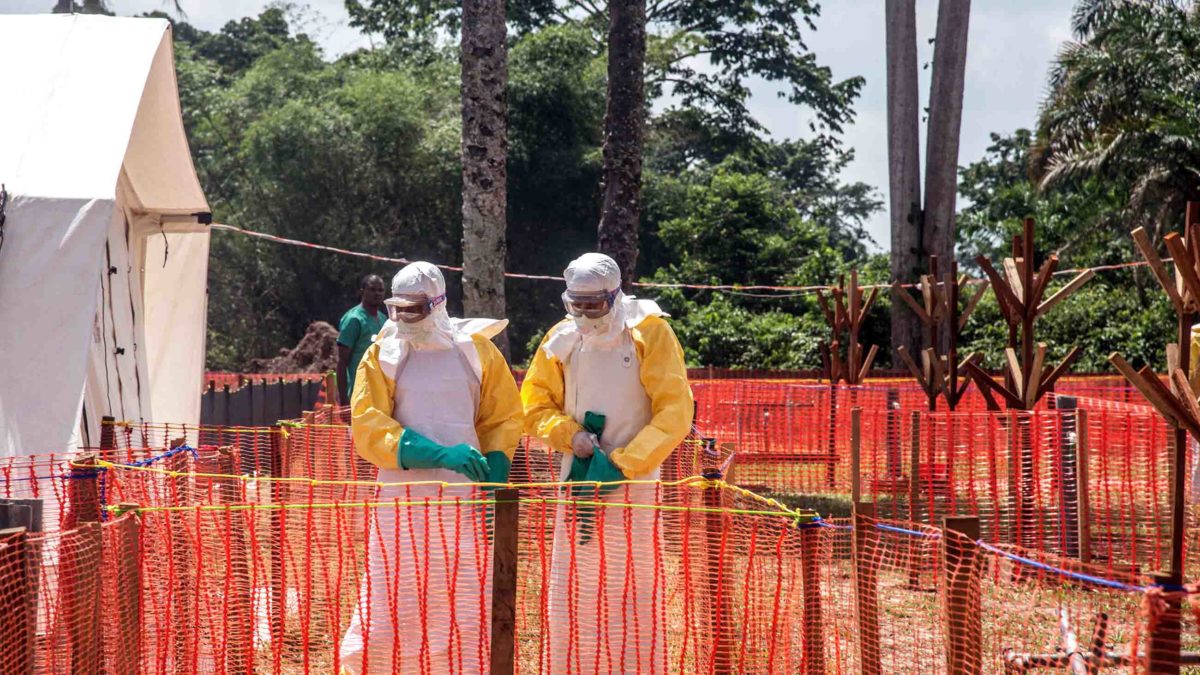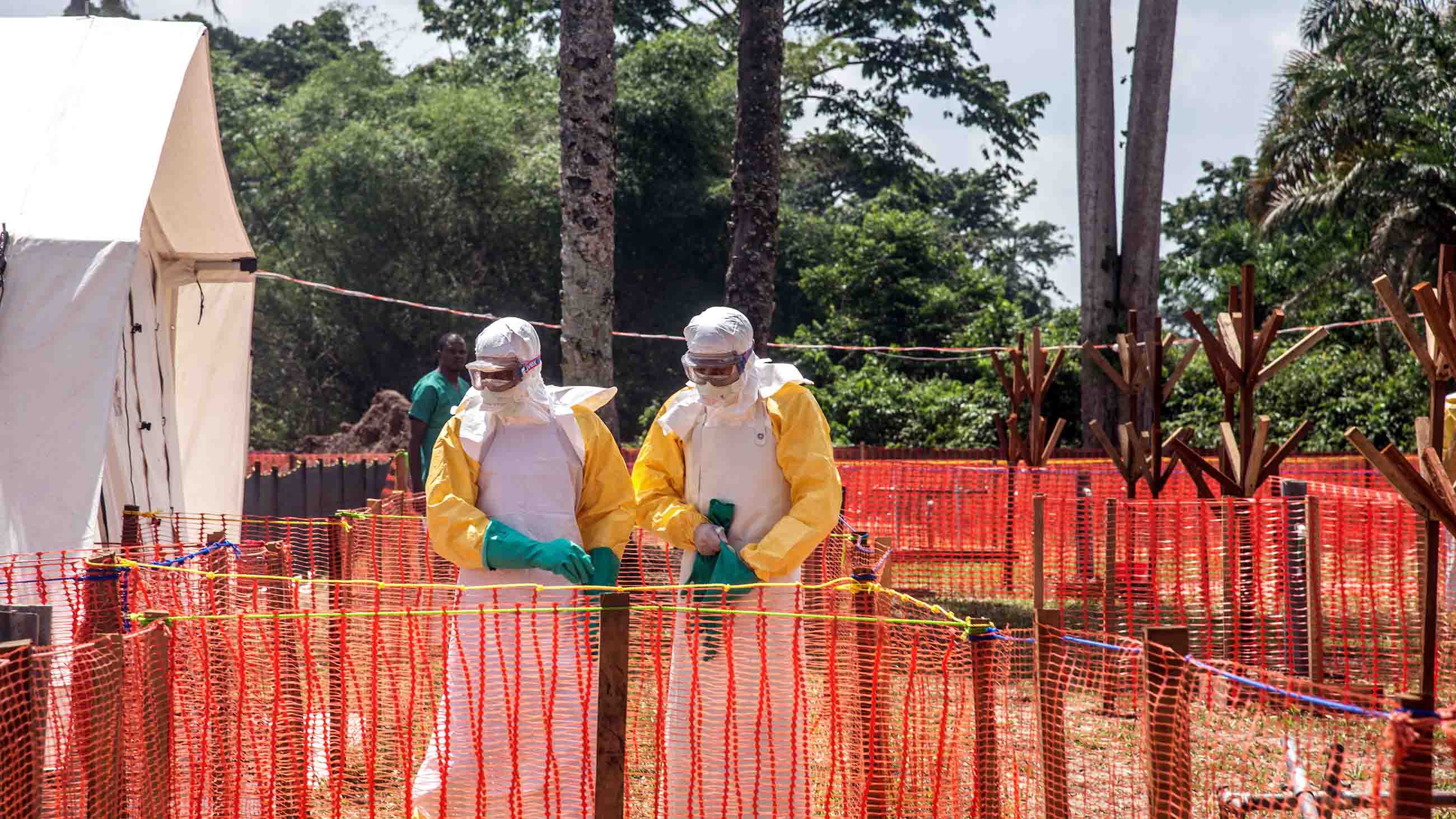As the Democratic Republic of Congo battles its ninth outbreak of Ebola since the virus was first discovered four decades ago, public health officials are hopeful that faster testing and an experimental vaccine will help stave off the type of devastation that befell West Africa in 2014.

Health workers operate within an Ebola safety zone in the Health Center in Iyonda, near Mbandaka, on June 1, 2018.
Visual: JUNIOR D. KANNAH/AFP/Getty Images
That epidemic, the largest outbreak of the deadly hemorrhagic disease on record, killed thousands of people across Liberia, Sierra Leone, and Guinea. Back then, health workers had to wait days to get lab results that would detect the Ebola virus, during which time people could unknowingly spread the infection.
Now armed with a genetic test that takes just hours, health personnel have confirmed 38 cases so far, including 14 deaths — and the spread of the disease seems to be slowing. Still, the head of the World Health Organization, Tedros Adhanom Ghebreyesus, cautioned this week that it’s too early to declare the outbreak under control. While more than 2,000 people have been vaccinated and health workers are carefully tracking who may have come in contact with those infected, many barriers to stopping the spread remain.
In the city of Mbandaka, for example, where four cases of Ebola have been confirmed, motorcycle taxi drivers argue that they should be vaccinated, as they’re often the ones called to transport patients to the hospital. “It’s not fair that only doctors and nurses are considered to be on the red line,” Benjamin Leli, president of the city’s taxi association, told the Associated Press. “We’re on the red line too, and I don’t want our people to get Ebola.”
While tracking down these drivers presents its own set of challenges, there’s also the issue of getting the vaccine to people in more rural areas like Iboko, where two new suspected cases were recently reported. Health workers there have encountered a lack of paved roads and cold storage, along with a general mistrust of the vaccinations being provided.
The Ebola vaccine isn’t guaranteed to stop the outbreak, of course, but the WHO decided it’s the best option after experiencing promising results when trialed during the 2014 outbreak. And once you’ve convinced people to get the vaccine, Dr. Alhassane Touré, the WHO vaccination coordinator in Congo and Guinea told the AP, “you’ve tackled 90 percent of the problem.”
Also in the news:
• The National Academies of Sciences, Engineering, and Medicine this week released its first report on the subject of sexual harassment at universities — and noted that academia’s track record has long been dismal in this regard; one study cited in the report found that up to 58 percent of academic employees have experienced some form of sexual harassment while at a university. In science, the problem appears to be the worst at medical schools, a finding that held up across the country. The 311-page report, titled “Sexual Harassment of Women”, noted that the number of women in academia had been rising steadily in recent decades, an achievement that put them in conflict with a system that the NAS described as far too tolerant of abusive behavior.”Despite significant attention in recent years, there is no evidence to suggest that current policies, procedures and approaches have resulted in a significant reduction in sexual harassment,” the authors concluded. The report was commissioned more than two years ago, when the #MeToo movement was revealing a series of scandals at universities. While the NAS report recommended some radical changes to the university system in order to combat such ongoing problems, the Academy itself faces criticism for retaining members found guilty of or facing accusations of sexual harassment, including astronomer Geoff Marcy, who resigned from the University of California-Berkeley in 2015, and cancer researcher Inder Verma, who resigned from the Salk Institute for Biological Research last week. (New York Times)
• The gene-editing technique called CRISPR has been widely hailed for its promise in fighting diseases from cancer to Lyme. In essence, it works by injecting a cell’s nucleus with molecules that can find disease-causing genes and either eliminate them or replace them with healthy ones. That’s the theory, anyway, but two papers published Monday in the journal Nature Medicine make clear that there’s much to be learned before promise becomes reality. Researchers from Novartis and the Karolinska Institute, using different types of cells, discovered that CRISPR was running afoul of a cancer-fighting gene called p53. The gene either prevented CRISPR from working effectively or killed healthy cells when it was switched on by CRISPR. The news caused the stocks of CRISPR companies to plummet, but scientists — whether involved in the studies or not — said that the results were preliminary and that there might well be work-arounds to avoid the p53 problem. (STAT)
• Antarctica’s ice sheet is melting at an alarming rate, one steadily increasing year after year, according to a comprehensive analysis published this week in the journal Nature. Since 1992, the continent has lost close to 3 trillion tons of ice, nearly half of which was shed in the past five years alone. Using satellite data that relied on three different methods — measuring the ice’s volume, its flow over the landscape, and the velocity of the moving glaciers — the researchers found that ice loss has already raised global sea levels by about a third of an inch. They predict that level will rise to 6 inches by the end of the century. Their findings paint a particularly bleak picture for much of North America, and the East Coast in particular. That’s because a rapid acceleration of ice sheet loss is concentrated in the western part of Antarctica, a vulnerable and unstable region of the continent whose melting glaciers directly impact the East Coast’s sea levels. “For every centimeter [of sea-level rise] from West Antarctica, Boston feels one and a quarter centimeters,” said Rob DeConto, a professor of climatology at the University of Massachusetts, Amherst who was not involved with the study. “And that extends down the East Coast.” (The Atlantic, New York Times)
• Eighteen states permit parents to opt their children out of school immunization requirements for non-medical reasons. And a new study finds that in two-thirds of those states, the number of unvaccinated children entering kindergarten is rising. The study, published on Tuesday in PLOS Medicine, designates several predominately rural counties across the country as hot spots, at heightened risk for outbreaks of measles, whooping cough, and other infectious diseases. Eight of the counties with the highest vaccination exemption rates were in Idaho. In Camas County, in the south of the state, 27 percent of kindergarteners were not vaccinated during the 2016-2017 school year. Fifteen major urban centers, including Seattle, Portland, and Salt Lake City also were found to have communities with increasing numbers of unimmunized children, representing the potential for rapidly spreading epidemics in densely populated areas with busy international airports. Overall, vaccination rates nationally remain high, but the number of communities with vaccination rates falling below 90-95 percent, the range widely acknowledged by epidemiologists to prevent the return of vaccine-preventable illnesses, is increasing. (Washington Post)
• Nearly 10 million Americans have had laser eye surgery since the procedure was first approved by the Food and Drug Administration in the 1990s. Drawn in by the allure of doing away with glasses and contact lenses, there is a widespread belief among patients that the surgery — which involves reshaping the clear outer layer of the eye, known as the cornea — is infallible. While the procedure is often touted as successful when patients achieve 20/20 vision, research and personal accounts suggest that many suffer from new problems including dry eyes, blurred vision, and light sensitivity. Indeed, a recent FDA clinical trial showed that about half of patients undergoing Lasik developed these sorts of issues. And a survey conducted by Consumer Reports in 2013 found that more than half of patients still had to wear glasses or contacts. In response to rising concerns about the procedure, the FDA said this week that it plans to issue new guidance detailing the risks. (New York Times)
• And finally, while Costa Rica enjoys a reputation for uncompromising environmental stewardship, that distinction is being questioned by activists working to force utilities in the Central American country to insulate their overhead power lines. The issue? Hundreds of rainforest critters that travel across the wires — including monkeys, sloths, and squirrels — are being electrocuted every year. A meeting last month resulted in an official proclamation recognizing the problem, which sees even those animals that survive coming away with missing limbs and severe burns. Still, it remains far from clear whether that will translate into government action. Said one former power company engineer: “I do not think that there will be significant changes in wildlife electrocution incidents.” (Undark)










